How to paint a wooden house outside with high quality and for a long time
Wood as a material for construction is experiencing another surge in popularity. The craving for naturalness and natural materials is understandable. But it is not enough to build a wooden house or a summer cottage, you need to provide them with proper care, and in order for the wood to serve for a long time and not lose its attractiveness, you need painting the house. When builders guarantee that a building made of wood will stand for a hundred years, they mean that it will be protected from destruction in a timely and correct manner.
The content of the article
Why you need to protect the tree
Professional builders recommend painting a wooden house right away to make it last longer. Unprotected wood is negatively affected by almost all environmental factors. If the tree is covered with bark in its living form, then only painting will protect the log cabins or boards.
- Exposed wood is destroyed by the sun's rays. Ultraviolet radiation affects lignin, a substance responsible for the lignification of plant cells. As a result, the tree darkens, becomes loose and moist. A radical change in the material occurs after six months of being in the open air. Since painting a wooden house over the destroyed surface layer will not bring the desired result, you must first sand the surface to an intact material.
- Log logs dry up and crack over time.
- Under the influence of ultraviolet radiation and temperature drops, the boards darkened and cracked
- Dry end of a log
- The alternation of rain and dry weather leads to the fact that the wood periodically swells and dries unevenly. The result of the process is cracks of various depths, which gradually increase. The house becomes ugly and its ability to retain heat decreases. In addition, mold fungi settle in the cracks, rotting begins.
- Changes in temperature during winter time cause moisture to enter the pores of the tree during a thaw and then freeze. Ice crystals are capable of tearing wood fibers, forming cracks in depth. Multiple repetition threatens that cracks will spread not only on the surface, but also throughout the entire thickness of the frame.
Exterior painting of a wooden house creates a protective layer that serves as a barrier to negative impact.
Types of paints
The abundance of modern paints and varnishes provides various options for solving the problem than painting a wooden house from the outside. All types of exterior or facade paint are divided into:
- glazing, that is, translucent, preserving the appearance and texture of wood, possessing antiseptic properties;
- covering - these are oil, acrylic and alkyd paints that form an additional layer over the wood.
Materials differ in composition, drying speed, appearance and other characteristics. Experts have not come to an unambiguous conclusion which paint is better to paint wooden houses outside, so you need to choose taking into account the wood from which the house is built (dry, damp, processed, old, and so on), and the climatic features of the area.
When choosing quality products, the safety of wood is ensured for up to 15 years. To achieve such a long and reliable effect is possible only if the rules for painting and preliminary preparation are observed.
Wood pretreatment
In order for the paint to lay down evenly, to be well absorbed and to serve for a long time, you need to prepare the surface for painting. Before treating a wooden house from the outside with any compound, antiseptic or fireproof, it is necessary to level the surface and seal the cracks.
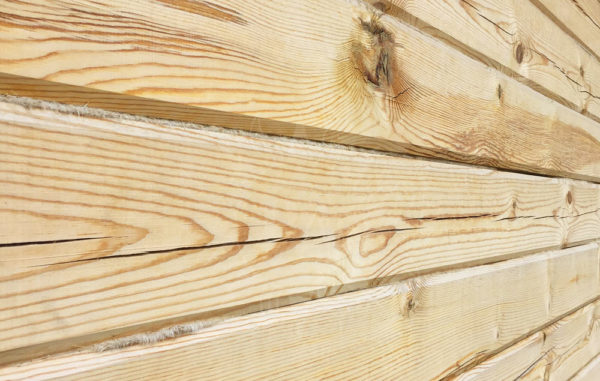
Having finished the construction of the house, it is necessary to seal the joints and putty the cracks
The main condition is that the wood must be dry with a moisture level of no more than 20%, therefore, preparation begins in a dry and warm season. If you put the paint on a damp surface, the internal moisture, when evaporated, will destroy the coating and tear it off the base.
The dry surface is cleaned of dust and dirt. If stains and spills are difficult to remove, a solvent can be used. Wood that was previously in the open air should preferably be sanded mechanically.
Additionally read the article "How to choose a sander for wood".
After sanding, painting is carried out within 48 hours in order to maintain the maximum effect of sanding.
First, the surface is treated with primer antiseptics or wood impregnations. Sometimes this work is undertaken by builders, but they often use the cheapest formulations - not very effective for wood preservation and environmentally unsafe. It is recommended to use water-based antiseptics that protect against mold, mildew and other biological formations on wood.
Antiseptics are applied in strict accordance with the instructions on the package. You can not deal with processing at low temperatures, even if manufacturers offer winter antiseptics.
The better to paint
The paint for the facade of a wooden house can be translucent, glossy or matte. Since the natural look of wood attracts most of all, glazing facade materials are very popular, which are available in the form of antiseptics, azure or oils.
The peculiarity of these materials is that they do not hide the structure of the wood. The materials work as impregnations, penetrate deeply and create a barrier to getting wet or exposure to ultraviolet rays (UV). Despite the transparency, glaze paints are available in a wide range of colors. The most famous manufacturers:
- Rhenocoll Germany.
- Teknos Finland.
If there is a desire to hide the surface of the wood, then they use facade covering paints, which are divided into:
- oil - made from oils of natural origin and organic solvents;
- alkyd - produced on organic solvents or aqueous solutions of alkyds;
- acrylate (acrylic) paintwork materials - based on acrylic and copolymers (latex, vinyl, silicone).
These paints form an opaque protective film that completely hides the wood grain. Over time, they oxidize, cease to be elastic and crack. Subsequently, the top layer turns into a powdery white substance (paint chalking process). After a few years, the layer will need to be removed in whole or in part and repeated work.
Acrylic paints are more expensive and highly flexible.
Well-known manufacturers of topcoats:
- Tikkurila (Finland).
- Alpina (Germany).
- Dufa (Germany).
- Beckers (Sweden).
- Dulux (Netherlands).
- Marshall (Turkey).
- Facade acrylic paint Dulux
- Tikkurila paints are well known here too
- Dufa wood preservative
Among the Russian brands, the most popular are Optimist, Svyatozar, Teks, and Yaroslavl Paints.
Average paint life:
- glazing antiseptics - 5 years;
- acrylic - 8-10 years;
- oil - up to 6 years;
- alkyd materials - 7 years.
When comparing different types of paint, their pros and cons are taken into account:
- oil paints - have a high penetrating power, reliably protect from moisture, but dry slowly (several days depending on temperature), which is sometimes unacceptable for outdoor work;
- alkyd compounds - they have good frost resistance, but over time they crack under the influence of UV;
- acrylic - convenient and easy to use, odorless, do not lose color, a new shade is easily obtained when mixing white paint with colorants (colored dyes), but if the house is painted with acrylic paint, then only them can be used in the future.
In recent years, acrylic paints and varnishes have taken the leading place, despite their higher price. Considering how much it costs to paint a wooden house and how much effort it takes, it is undesirable to focus on cheap views. It is better to do it well once, than after 2-3 years the house will look sloppy. Immediately choose how to paint a private house or summer cottage outside for a long time, even if you have to invest more.
The total cost of painting depends mainly on the size of the house. This amount will include the cost of antiseptic, putty and paint.
What color to choose
The choice of color depends only on the wishes of the homeowner. Manufacturers offer a wide range of shades. Usually preferences depend on the design of the house and the place where it is located. To make the house visually blend in with the environment, various shades of green, sand, brown are chosen.
To highlight the building on the ground, you can use bright white, blue, yellow. The most effective is the combination of two colors - light and dark.
A significant part of developers are more focused on the practical effect of painting, for example, dark colors attract rays, the surface heats up too much and cracks form on the wood. Light shades reflect light, do not fade longer, but dirt is better visible on them. Light gray color fade least of all.
If resin appears on the wood, then light dyes are preferred so that the wood does not heat up. Resinous discharge is less noticeable against the background of cream, white, ivory.
Often the paint is chosen according to the combination or contrast with the color of the roofing material.
Additionally, we recommend the article "Mixing colors to get the desired color".
Painting sequence
To paint a wooden house correctly, you need to follow the technology and the sequence of actions. A frame house is painted according to the same rules as a log house.
- First of all, they clean the surface of dust, construction debris, resin drips - otherwise, mixed with paint, foreign particles will remain on the facade. If this is not the first treatment of the building, then carefully remove the previous paint and clean the surface to wood.
- Then carry out mechanical grinding of the surface by hand or using a grinding machine. Grinding and further painting are carried out with a short break, no more than 3 days, so that the cleaned base does not have time to suffer from external factors.
- Cracks, irregularities and damaged spots are putty in the old house. If nails or other metal elements protrude from the tree, then they are covered with a special primer intended for metal.
- After that, the entire surface is covered with a primer with antiseptic properties and impregnations. The primer will not only perform protective functions - after its application, paint consumption is noticeably reduced and it lays down more evenly.
- Then go directly to painting. The paint is applied with a roller or sprayed with a spray gun. It should be borne in mind that acrylic facade paintwork is too thick and viscous - only a professional tool is suitable for them. To use household sprayers, the paint will have to be diluted, that is, the layer will be thinner than the manufacturers recommend.
- Coloring is done in several layers. Each next layer is applied only after the previous one is completely dry. When painting with a roller or brush, paint should be applied along the grain of the wood.
Painting nuances
Since not all materials fit well on each other, it is imperative to remember which paint was used previously (oil, alkyd, acrylic). If the painting work is carried out by specialists, this issue needs to be clarified with them. At the first painting with acrylic paints, in the future you will have to purchase only the same paintwork materials or compatible with them.

Compatibility table of paints and varnishes. If the cell is colored blue, then the paintwork materials are compatible. Least of all restrictions on the use of acrylate water-dispersion paints and varnishes. From the table it can be seen that alkyd-acrylic cannot be applied over the oil paint, but alkyd-styrene can
An old house will require careful repair of cracks. Even after that, it is better to paint with a brush, since the roller will skip irregularities, microcracks and other problem areas. If the old wood has traces of damage by pests, then it is additionally treated with insecticides and antiseptics.
Particular attention is paid to the ends, as the most vulnerable elements to moisture. They are painted in 4–5 layers.
Basic requirements for painting a wooden house:
- performed immediately after construction, and then at intervals depending on the type of paint;
- pre-treatment with antiseptics and a primer is imperative;
- it is desirable to carry out grinding;
- paint is applied in several layers.

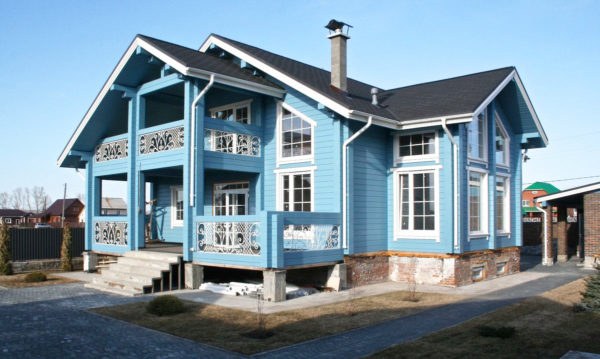
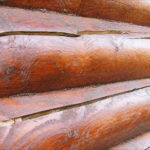
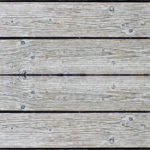
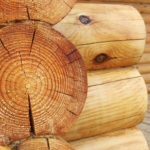
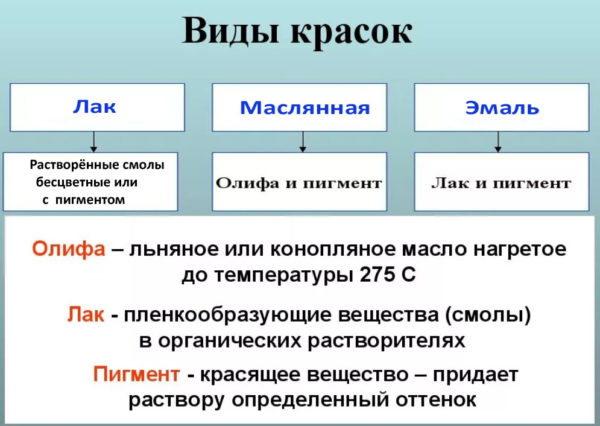
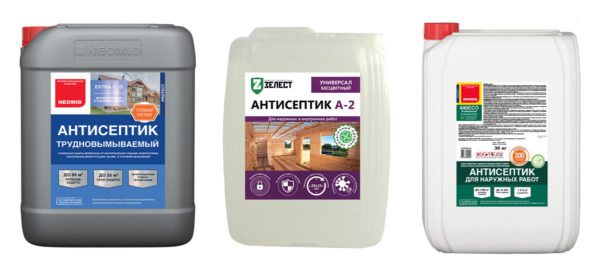

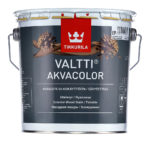
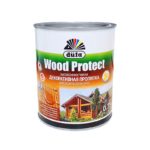
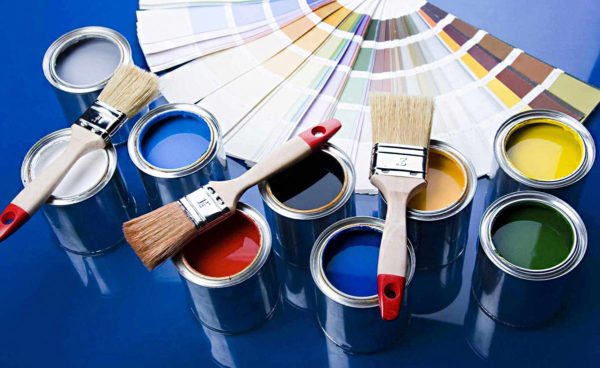

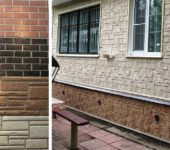
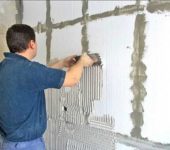
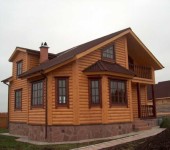
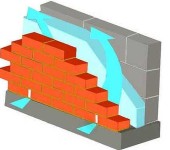





Useful table. Ever since my school days, I remember that you cannot paint over oil paint with nitro-enamel - the paint swells.